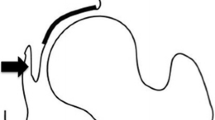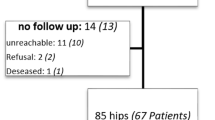Abstract
Background
This study was performed to evaluate whether the radiographic crossover sign influences the painful femoroacetabular impingement or the radiographic progression of osteoarthritis after rotational acetabular osteotomy (RAO).
Methods
A total of 104 patients (115 hips) with preosteoarthritis (pre-OA) or early-stage OA of the hip due to dysplasia underwent RAO. Their mean age at the time of surgery was 34.7 years. The mean follow-up period was 13 years. Clinical follow-up was performed with the system of Merle d’Aubigne, and the impingement sign was evaluated. Radiographic analyses included the center-edge angle, acetabular roof angle, head lateralization index (HLI), joint congruency, crossover sign, posterior wall sign, acetabular index of depth to width, pistol grip deformity, and femoral head/femoral neck ratio.
Results
The mean clinical score improved significantly from 14.6 preoperatively to 17.0 at follow-up. The impingement sign at follow-up was observed in 14 hips (12.2%). The center-edge angle, acetabular roof angle, and head lateralization index (HLI) improved significantly after surgery. The crossover sign was observed in 8 hips (7.0%) preoperatively and in 49 hips (42.6%) postoperatively. The posterior wall sign was observed in 70 hips (60.9%) preoperatively and in 73 hips (63.5%) postoperatively. The impingement sign after RAO was positive significantly in the postoperative crossover sign-positive hips. Radiographic progression of OA was observed in 11 hips (crossover sign was positive in 7 hips and negative in 4 hips). The only factors significantly associated with radiographic progression after RAO were fair postoperative joint congruency and age at surgery.
Conclusions
Although there was no significant radiographic progression of OA despite significant retroversion, anterior impingement and radiographic crossover sign after RAO are should be checked during the procedure. The goal of RAO should be correct alignment of the acetabulum including a correct version with a negative crossover sign.
Similar content being viewed by others
References
Aronson, J. Osteoarthritis of the young adult hip: etiology and treatment. Instr Course Lect 1986;35:119–128.
Millis MB, Murphy SB, Poss R. Osteotomies about the hip for the prevention and treatment of osteoarthrosis. J Bone Joint Surg Am 1995;77:626–647.
Steel HH. Triple osteotomy of the innominate bone. J Bone Joint Surg Am 1973;55:343–350.
Eppright RH. Dial osteotomy of the acetabulum in the treatment of dysplasia of the hip. J Bone Joint Surg Am 1975;57:1172.
Wagner H. Osteotomies for congenital hip dislocation. In: The hip. St. Louis: Mosby; 1976. p. 45–66.
Ninomiya S, Tagawa H. Rotational acetabular osteotomy for the dysplastic hip. J Bone Joint Surg Am 1984;66:430–436.
Ganz R, Klaue K, Vinh TS, Mast JW. A new peri-acetabular osteotomy for the treatment of hip dysplasia: technique and preliminary results. Clin Orthop 1988;232:26–36.
Trousdale RT, Ekkernkamp A, Ganz R, Wallrichs SL. Periacetabular and intertrochanteric osteotomy for the treatment of osteoarthrosis in dysplastic hips. J Bone Joint Surg Am 1995;77:73–85.
Nakamura S, Ninomiya S, Takatori Y, Morimoto S, Umeyama T. Long-term outcome of rotational acetabular osteotomy: 145 hips followed for 10–23 years. Acta Orthop Scand 1998;69:259–265.
Schramm M, Pitto RP, Rohm E, Hohmann D. Long-term results of spherical acetabular osteotomy. J Bone Joint Surg Br 1999;81:60–66.
Yasunaga Y, Ikuta Y, Shigenobu T, Nakamura S, Yamamoto S, Nakashiro J. Rotational acetabular osteotomy for dysplastic hip dysplasia; medial enlargement of the acetabulum. Acta Orthop Scand 2001;72:8–12.
Yasunaga Y, Ochi M, Shimogaki K, Yamamoto S, Iwamori H. Rotational acetabular osteotomy for hip dysplasia: 61 hips followed for 8–15 years. Acta Orthop Scand 2004;75:10–15.
Ganz R, Leunig M, Leunig-Ganz K, Harris WH. The etiology of osteoarthritis of the hip. Clin Orthop 2008;466:264–272.
Siebenrock KA, Scholl E, Lottenback M, Ganz R. Bernese periacetabular osteotomy. Clin Orthop 1999;363:9–20.
Meyers SR, Eijer H, Ganz R. Anterior femoroacetabular impingement after periacetabular osteotomy. Clin Orthop 1999;363:93–99.
Steppacher SD, Tannast M, Werlen S, Siebenrock A. Femoral morphology differs between deficient and excessive acetabular coverage. Clin Orthop 2008;466:782–790.
Charnley J. Numerical grading of clinical results. In: Charnley J, editor. Low friction arthroplasty of the hip. Berlin: Springer; 1979. p. 20–24.
Wiberg G. Studies on dysplastic acetabula and congenital subluxation of the hip joint: with special reference to the complication of osteoarthritis. Acta Chir Scand 1939;83(suppl):58.
Yasunaga Y, Kanazawa T, Ikuta Y, Takahashi K, Hisatome T. The state of the articular cartilage at the time of surgery as an indication for rotational acetabular osteotomy. J Bone Joint Surg Br 2001;83:1001–1004.
Yasunaga Y, Terayama H, Tanaka R, Yamasaki T, Ishii Y, Ochi M. Rotational acetabular osteotomy: surgical techniques. J Bone Joint Surg Am 2007;89(suppl 2):246–255.
Merle d’Aubigne R, Postel M. Functional results of hip arthroplasty with acrylic prosthesis. J Bone Joint Surg Am 1954;36:451–475.
Klaue K, Durnin CW, Ganz R. The acetabular rim syndrome: a clinical presentation of dysplasia of the hip. J Bone Joint Surg Br 1991;73:423–429.
Siebenrock KA, Kalbermatten DF, Ganz R. Effect of pelvic tilt on acetabular retroversion: a study of pelves from cadavers. Clin Orthop 2003;407:241–248.
Massie WK, Howorth MB. Congenital dislocation of the hip: Part 1. Method of grading results. J Bone Joint Surg Am 1950;32:519–531.
Hijikata H, Tagawa H, Toyoshima H. Rotational acetabular osteotomy with resection of capital drop. Hip Joint 1985;11:277–282 (in Japanese).
Reynolds D, Lucas J, Klaue K. Retroverted of the acetabulum. J Bone Joint Surg Br 1999;81:281–288.
Heyman CH, Herndon CH. Legg-Perthes disease: a method for the measurement of roentgenographic results. J Bone Joint Surg Am 1950;32:767–778.
Stulberg SD, Cordell LD, Harris WH, Ramsey PL, MacEwen GD. Unrecognised childhood hip disease: a major cause of idiopathic osteoarthritis of the hip. In: Proceedings of the third open scientific meeting of the Hip Society. St. Louis: Mosby; 1975. p. 212–218.
Doherty M, Courtney P, Doherty S, Jenkins W, Maciewicz RA, Muir K, et al. Nonspherical femoral head shape (pistol grip deformity), neck shaft angle, and risk of hip osteoarthritis: a casecontrol study. Arthritis Rheum 2008;58:3172–3182.
Murphy SB, Ganz R, Muller ME. The prognosis in untreated dysplasia of the hip: a study of radiographic factors that predict the outcome. J Bone Joint Surg Am 1995;77:985–989.
Author information
Authors and Affiliations
About this article
Cite this article
Yasunaga, Y., Yamasaki, T., Matsuo, T. et al. Crossover sign after rotational acetabular osteotomy for dysplasia of the hip. J Orthop Sci 15, 463–469 (2010). https://doi.org/10.1007/s00776-010-1489-6
Received:
Accepted:
Published:
Issue Date:
DOI: https://doi.org/10.1007/s00776-010-1489-6




